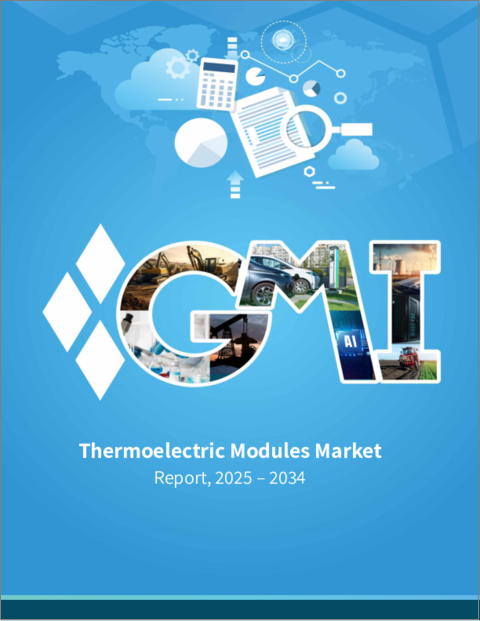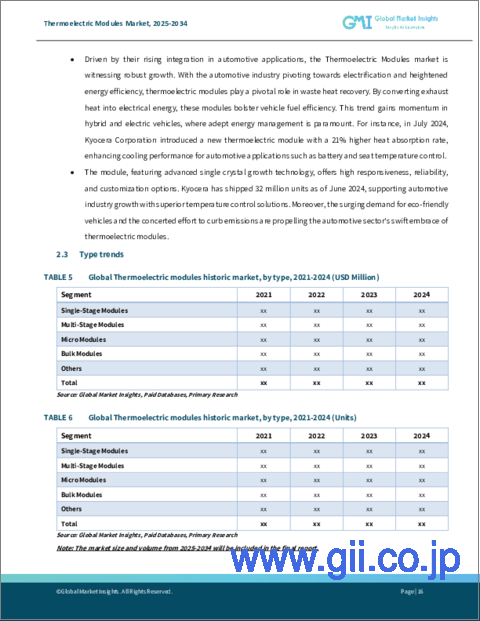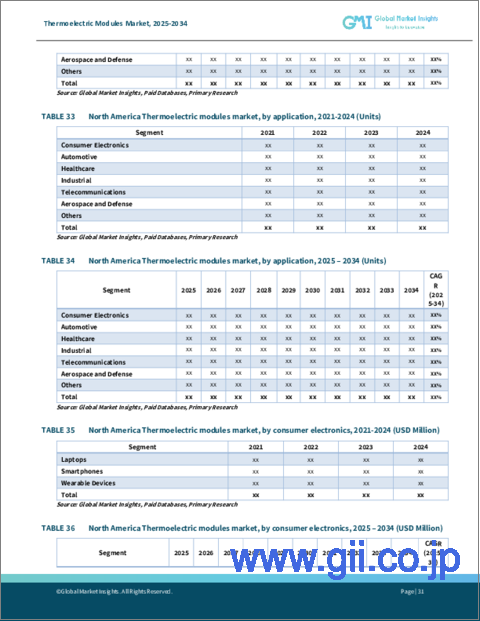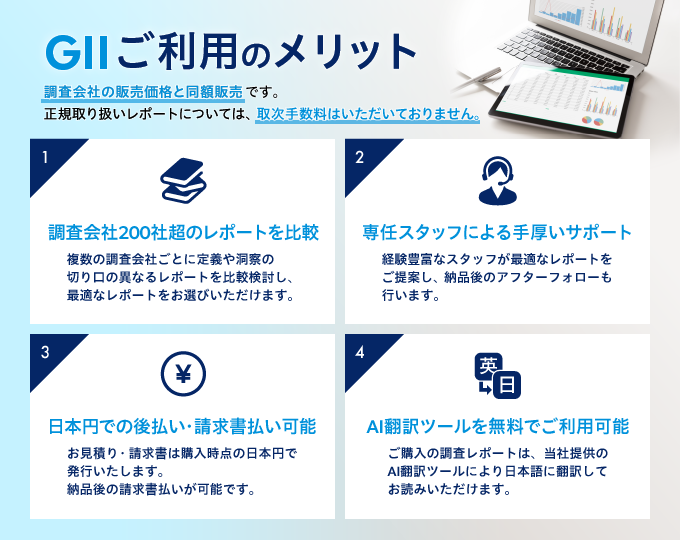|
|
市場調査レポート
商品コード
1572459
熱電モジュール市場、機会、成長促進要因、産業動向分析と予測、2024年~2032年Thermoelectric Modules Market, Opportunity, Growth Drivers, Industry Trend Analysis and Forecast, 2024-2032 |
||||||
カスタマイズ可能
|
|||||||
| 熱電モジュール市場、機会、成長促進要因、産業動向分析と予測、2024年~2032年 |
|
出版日: 2024年08月19日
発行: Global Market Insights Inc.
ページ情報: 英文 206 Pages
納期: 2~3営業日
|
全表示
- 概要
- 目次
熱電モジュールの世界市場は、2023年には5億5,000万米ドルと評価され、2024年から2032年にかけてCAGR 10%以上で成長すると予測されています。
米国エネルギー省は、廃熱回収によって工業プロセスのエネルギーを最大20%節約できると強調しています。産業界、特に自動車や製造業がエネルギー消費とカーボンフットプリントの削減を目指しているため、熱電モジュールの需要が急増しています。これらのモジュールは、持続可能なエネルギー回収ソリューションを提供するだけでなく、コスト削減や環境面でのメリットも期待できるため、さまざまな分野で受け入れられています。
自動車部門が電動化とエネルギー効率の改善へとシフトする中、熱電モジュールは排熱回収に不可欠です。排気熱を電気エネルギーに変換することで、これらのモジュールは、特にエネルギー管理が重要なハイブリッド車や電気自動車において、自動車の燃料効率を高めます。例えば、2024年7月、京セラ株式会社は、バッテリーやシート温度制御のような自動車機能の冷却を最適化する、21%高い熱吸収率を誇る熱電モジュールを発売しました。単結晶成長技術を活用したこの先進的なモジュールは、高い応答性、信頼性、カスタマイズ性を約束します。2024年6月までに京セラは3,200万個を出荷し、自動車用温度制御ソリューションの進歩における京セラの役割を裏付けています。さらに、自動車セクターのサーモエレクトリック・モジュールの迅速な採用は、環境に優しい自動車への需要の高まりと排出ガス削減への取り組みが原動力となっています。
熱電モジュール産業は、タイプ、技術、機能、用途、地域によって分類されます。
市場は、熱電モジュールをシングルステージ、マルチステージ、マイクロ、バルク、その他のモジュールに分類しています。シングルステージモジュールセグメントは、温度差が緩やかなアプリケーションに適しているため、2032年までに4億米ドルを超えると予測されています。民生用電子機器や小型冷却システムで一般的に使用されるこのモジュールは、シンプルさと費用対効果を優先しています。シンプルな設計のため、製造コストが低く、統合も容易です。しかし、その性能は多段モジュールと比較すると限定的で、あまり集中的でない冷却ニーズに適しています。
熱電モジュール市場は、機能を冷却、加熱、発電にセグメント化し、加熱セグメントが2024年から2032年までのCAGR10.5%以上でリードしています。冷却用に設計された熱電モジュールは、熱を移動させて温度差を生じさせる。これは電子機器、医療機器、ポータブルクーラーの冷却に不可欠です。正確な温度制御が可能なため、コンパクトで効率的な冷却ニーズに最適ですが、一般的に他の方法よりもエネルギー効率が低く、その性能は周囲温度や消費電力に影響されます。
北米の熱電モジュール市場は、技術的進歩と大幅な研究開発投資により、2023年には38%を超えるシェアを占めました。特に自動車、航空宇宙、エレクトロニクスにおけるエネルギー効率と持続可能性への注目は、先進的なサーモエレクトリックソリューションの需要を促進しています。強固なインフラ、ハイテク企業の集積、クリーンエネルギーと革新的な冷却技術に対する政府の強力な支援により、北米では熱電モジュールの採用が顕著に増加しています。これらのモジュールは現在、廃熱回収から高性能システムの温度調整まで、さまざまな用途で採用されています。
目次
第1章 調査手法と調査範囲
第2章 エグゼクティブサマリー
第3章 業界洞察
- エコシステム分析
- ベンダー・マトリックス
- 利益率分析
- テクノロジーとイノベーションの展望
- 特許分析
- 主要ニュースと取り組み
- 規制状況
- 影響要因
- 促進要因
- エネルギー効率に対する需要の増加
- 熱電材料技術の進歩
- 自動車産業での用途拡大
- 民生用電子機器分野での採用増加
- 支援的な政府規制とインセンティブ
- 業界の潜在的リスク&課題
- 熱電材料の高コスト
- 特定の用途における効率の限界
- 促進要因
- 成長可能性分析
- ポーター分析
- PESTEL分析
第4章 競合情勢
- イントロダクション
- 企業シェア分析
- 競合のポジショニング・マトリックス
- 戦略展望マトリックス
第5章 市場推計・予測:タイプ別、2021年~2032年
- 主要動向
- シングルステージモジュール
- 多段モジュール
- マイクロモジュール
- バルクモジュール
- その他
第6章 市場推計・予測:技術別、2021年~2032年
- 主要動向
- テルル化ビスマス(Bi2Te3)
- テルル化鉛(PbTe)
- シリコンゲルマニウム(SiGe)
- その他
第7章 市場推計・予測:機能別、2021年~2032年
- 主要動向
- 冷却
- 暖房
- 発電
第8章 市場推計・予測:用途別、2021年~2032年
- 主要動向
- 家電
- ノートパソコン
- スマートフォン
- ウェアラブルデバイス
- 自動車
- 廃熱回収
- 空調シート
- ヘルスケア
- 医療機器
- 検査機器
- 産業用
- 産業プロセス冷却
- 発電
- 通信機器
- 電子部品の冷却
- 航空宇宙および防衛
- 宇宙船の熱管理
- 軍事機器の冷却
- その他
- ウェアラブル
- IoTデバイス
第9章 市場推計・予測:地域別、2021年~2032年
- 主要動向
- 北米
- 米国
- カナダ
- 欧州
- 英国
- ドイツ
- フランス
- イタリア
- スペイン
- その他欧州
- アジア太平洋
- 中国
- インド
- 日本
- 韓国
- ニュージーランド
- その他アジア太平洋地域
- ラテンアメリカ
- ブラジル
- メキシコ
- その他ラテンアメリカ
- 中東・アフリカ
- UAE
- 南アフリカ
- サウジアラビア
- その他の中東・アフリカ
第10章 企業プロファイル
- Ferrotec Corporation
- II-VI Incorporated
- Laird Thermal Systems
- TE Technology, Inc.
- KELK Ltd.
- Custom Thermoelectric
- RMT Ltd.
- Thermonamic Electronics(Jiangxi)Corp., Ltd.
- EVERREDtronics Ltd.
- Kryotherm
- Thermion Company
- Adcol Electronics(Guangzhou)Co., Ltd.
- Wellen Technology Co., Ltd.
- Z-MAX Co., Ltd.
- Align Sourcing LLC
- Komatsu Ltd.
- Hi-Z Technology, Inc.
- Phononic, Inc.
- LG Innotek
- Gentherm Incorporated
- Micropelt GmbH
- Global Power Technologies
- AMS Technologies
- Analytic Industries Inc.
- Merit Technology Group
The Global Thermoelectric Modules Market was valued at USD 550 million in 2023 and is projected to grow at over 10% CAGR from 2024 to 2032, owing to the ability to convert waste heat into electricity, thus boosting energy efficiency. The U.S. Department of Energy highlights that waste heat recovery could save up to 20% of energy in industrial processes. As industries, particularly in automotive and manufacturing, aim to reduce energy consumption and carbon footprints, the demand for thermoelectric modules is surging. These modules not only offer a sustainable energy recovery solution but also promise cost savings and environmental benefits, driving their acceptance across various sectors.
As the automotive sector shifts towards electrification and improved energy efficiency, thermoelectric modules are crucial for waste heat recovery. By converting exhaust heat into electrical energy, these modules enhance vehicle fuel efficiency, especially in hybrid and electric vehicles where energy management is critical. For example, in July 2024, Kyocera Corporation launched a thermoelectric module boasting a 21% higher heat absorption rate, optimizing cooling for automotive features like battery and seat temperature control. This advanced module, utilizing single crystal growth technology, promises high responsiveness, reliability, and customization. By June 2024, Kyocera had shipped 32 million units, underscoring its role in advancing automotive temperature control solutions. Additionally, the automotive sector's swift adoption of thermoelectric modules is driven by the rising demand for eco-friendly vehicles and efforts to reduce emissions.
The thermoelectric modules industry is classified based on type, technology, functionality, application and region.
The market categorizes thermoelectric modules into single-stage, multi-stage, micro, bulk, and other modules. The single-stage modules segment is projected to exceed USD 400 million by 2032, as they are suited for applications with moderate temperature differences. Commonly used in consumer electronics and compact cooling systems, they prioritize simplicity and cost-effectiveness. Their straightforward design allows for lower production costs and easier integration. However, their performance is limited compared to multi-stage modules, making them suitable for less intensive cooling needs.
The thermoelectric modules market segments functionality into cooling, heating, and power generation, with the heating segment leading at a CAGR of over 10.5% from 2024 to 2032. Designed for cooling, thermoelectric modules shift heat to create a temperature difference. This is vital for cooling electronic devices, medical equipment, and portable coolers. Their precise temperature control makes them ideal for compact and efficient cooling needs, though they are generally less energy-efficient than other methods and their performance can be influenced by ambient temperature and power consumption.
North America thermoelectric modules market held a share exceeding 38% in 2023, due to the technological advancements and substantial R&D investments. The focus on energy efficiency and sustainability, especially in automotive, aerospace, and electronics, fuels the demand for advanced thermoelectric solutions. With a robust infrastructure, a concentration of tech companies, and strong governmental support for clean energy and innovative cooling technologies, North America has witnessed a notable rise in thermoelectric module adoption. These modules are now employed in a range of applications, from waste heat recovery to regulating temperatures in high-performance systems.
Table of Contents
Chapter 1 Methodology and Scope
- 1.1 Market scope and definition
- 1.2 Base estimates and calculations
- 1.3 Forecast calculation
- 1.4 Data sources
- 1.4.1 Primary
- 1.4.2 Secondary
- 1.4.2.1 Paid sources
- 1.4.2.2 Public sources
Chapter 2 Executive Summary
- 2.1 Industry 360º synopsis, 2021 - 2032
Chapter 3 Industry Insights
- 3.1 Industry ecosystem analysis
- 3.2 Vendor matrix
- 3.3 Profit margin analysis
- 3.4 Technology and innovation landscape
- 3.5 Patent analysis
- 3.6 Key news and initiatives
- 3.7 Regulatory landscape
- 3.8 Impact forces
- 3.8.1 Growth drivers
- 3.8.1.1 Increasing demand for energy efficiency
- 3.8.1.2 Advancements in thermoelectric material technology
- 3.8.1.3 Growing applications in the automotive industry
- 3.8.1.4 Rising adoption in the consumer electronics sector
- 3.8.1.5 Supportive government regulations and incentives
- 3.8.2 Industry pitfalls and challenges
- 3.8.2.1 High cost of thermoelectric materials
- 3.8.2.2 Limited efficiency in certain applications
- 3.8.1 Growth drivers
- 3.9 Growth potential analysis
- 3.10 Porter's analysis
- 3.10.1 Supplier power
- 3.10.2 Buyer power
- 3.10.3 Threat of new entrants
- 3.10.4 Threat of substitutes
- 3.10.5 Industry rivalry
- 3.11 PESTEL analysis
Chapter 4 Competitive Landscape, 2023
- 4.1 Introduction
- 4.2 Company market share analysis
- 4.3 Competitive positioning matrix
- 4.4 Strategic outlook matrix
Chapter 5 Market Estimates and Forecast, By Type, 2021 - 2032 (USD Million and Units)
- 5.1 Key trends
- 5.2 Single-Stage modules
- 5.3 Multi-Stage modules
- 5.4 Micro modules
- 5.5 Bulk modules
- 5.6 Others
Chapter 6 Market Estimates and Forecast, By Technology, 2021 - 2032 (USD Million and Units)
- 6.1 Key trends
- 6.2 Bismuth Telluride (Bi2Te3)
- 6.3 Lead Telluride (PbTe)
- 6.4 Silicon Germanium (SiGe)
- 6.5 Others
Chapter 7 Market Estimates and Forecast, By Functionality, 2021 - 2032 (USD Million and Units)
- 7.1 Key trends
- 7.2 Cooling
- 7.3 Heating
- 7.4 Power generation
Chapter 8 Market Estimates and Forecast, By Application, 2021 - 2032 (USD Million and Units)
- 8.1 Key trends
- 8.2 Consumer electronics
- 8.2.1 Laptops
- 8.2.2 Smartphones
- 8.2.3 Wearable devices
- 8.3 Automotive
- 8.3.1 Waste heat recovery
- 8.3.2 Climate control seats
- 8.4 Healthcare
- 8.4.1 Medical devices
- 8.4.2 Laboratory equipment
- 8.5 Industrial
- 8.5.1 Industrial process cooling
- 8.5.2 Power generation
- 8.6 Telecommunications
- 8.6.1 Cooling of Electronic Components
- 8.7 Aerospace and Defense
- 8.7.1 Thermal Management in Spacecraft
- 8.7.2 Military equipment cooling
- 8.8 Others
- 8.8.1 Wearables
- 8.8.2 IoT Devices
Chapter 9 Market Estimates and Forecast, By Region, 2021 - 2032 (USD Million and Units)
- 9.1 Key trends
- 9.2 North America
- 9.2.1 U.S.
- 9.2.2 Canada
- 9.3 Europe
- 9.3.1 UK
- 9.3.2 Germany
- 9.3.3 France
- 9.3.4 Italy
- 9.3.5 Spain
- 9.3.6 Rest of Europe
- 9.4 Asia Pacific
- 9.4.1 China
- 9.4.2 India
- 9.4.3 Japan
- 9.4.4 South Korea
- 9.4.5 ANZ
- 9.4.6 Rest of Asia Pacific
- 9.5 Latin America
- 9.5.1 Brazil
- 9.5.2 Mexico
- 9.5.3 Rest of Latin America
- 9.6 MEA
- 9.6.1 UAE
- 9.6.2 South Africa
- 9.6.3 Saudi Arabia
- 9.6.4 Rest of MEA
Chapter 10 Company Profiles
- 10.1 Ferrotec Corporation
- 10.2 II-VI Incorporated
- 10.3 Laird Thermal Systems
- 10.4 TE Technology, Inc.
- 10.5 KELK Ltd.
- 10.6 Custom Thermoelectric
- 10.7 RMT Ltd.
- 10.8 Thermonamic Electronics (Jiangxi) Corp., Ltd.
- 10.9 EVERREDtronics Ltd.
- 10.10 Kryotherm
- 10.11 Thermion Company
- 10.12 Adcol Electronics (Guangzhou) Co., Ltd.
- 10.13 Wellen Technology Co., Ltd.
- 10.14 Z-MAX Co., Ltd.
- 10.15 Align Sourcing LLC
- 10.16 Komatsu Ltd.
- 10.17 Hi-Z Technology, Inc.
- 10.18 Phononic, Inc.
- 10.19 LG Innotek
- 10.20 Gentherm Incorporated
- 10.21 Micropelt GmbH
- 10.22 Global Power Technologies
- 10.23 AMS Technologies
- 10.24 Analytic Industries Inc.
- 10.25 Merit Technology Group





